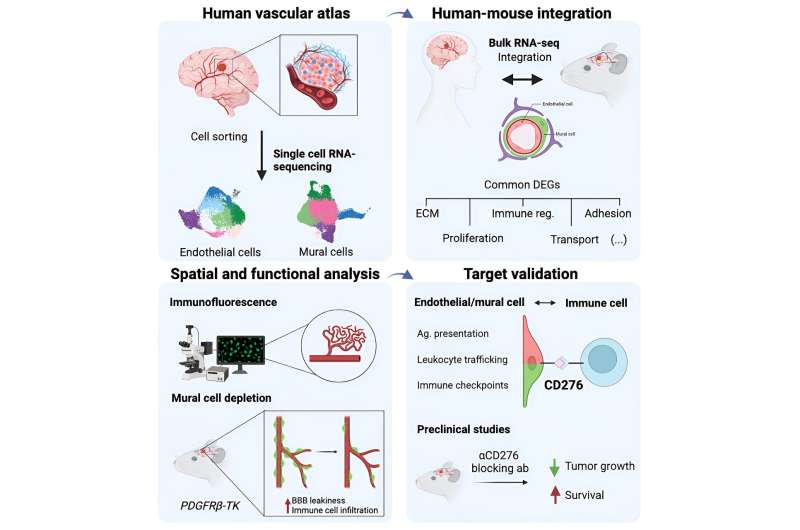This article has been reviewed according to Science X's editorial process and policies. Editors have highlighted the following attributes while ensuring the content's credibility:
fact-checked
peer-reviewed publication
trusted source
proofread
Analysis of brain tumor blood vessels yields a candidate therapy—and a platform to find more

A Ludwig Cancer Research study has generated a granular portrait of how the cellular and molecular components of the blood vessels that feed brain metastases of melanoma and lung and breast cancers differ from those of healthy brain tissue, illuminating how they help shape the internal environment of tumors to support cancer growth and immune evasion.
Led by Ludwig Lausanne's Leire Bejarano and Johanna Joyce, researchers also developed a platform to identify potentially targetable vulnerabilities in the vasculature of brain metastases. They report in the current issue of Cancer Cell their identification of one such target—a protein known as CD276—and show that its inhibition by antibodies markedly extends the survival of mice engineered to develop brain metastases of breast cancer.
"These findings represent a significant advance in our understanding of the complex interactions of blood vessels, immune cells, and cancer cells within the brain and hold promise for the development of therapies that can target brain tumors in new and more effective ways," said Joyce. "There's a dire need for such therapies as most patients with brain metastases of these cancers survive less than one year after diagnosis."
Like all solid tumors, brain metastases rely on a diverse crew of noncancerous cells that they often manipulate to survive and thrive. This includes not only immune cells—like macrophages and neutrophils—but also fibroblasts and, crucially, the cellular components of new blood vessels, without which tumors cannot grow at all.
The Joyce lab has extensively analyzed the immune landscapes of primary and metastatic brain tumors, identifying their constituent cells, examining how those cells are biochemically manipulated and functionally altered in each tumor type and harnessing those discoveries to advance new strategies to address tumor recurrence and resistance to therapy.
But far less is known about the vasculature of brain tumors, where new blood vessels engendered by cancer cells establish a functionally distinct blood-tumor barrier that serves and protects them, much as the blood-brain barrier does for healthy brain tissue.
To fill that gap, Bejarano, Joyce, and colleagues conducted a deep analysis of the molecular features and gene expression patterns of cells that form the blood-brain barrier in noncancerous brain tissue and metastatic brain tumor samples freshly isolated from patients with the three major cancers. They then focused on endothelial cells (ECs), which line the inner vascular surface, and mural cells—pericytes and smooth muscle cells—that swaddle and stabilize blood vessels.
Their analysis revealed significant differences between gene expression patterns in these cells and those of the same cells obtained from noncancerous brain tissue. The patterns suggested multiple aberrations in tumor vessels, including problems in the intercellular junctions and adhesiveness of ECs and mural cells—reflecting the well-known "leakiness" of tumor blood vessels—and their elevated interactions with certain subsets of immune cells.
These findings and others obtained using advanced imaging methods were recapitulated in studies conducted in mouse models of brain metastasis.
"This agreement validated our analysis of the brain tumor vasculature and supported the subsequent use of our mouse models as platforms for the identification and preclinical evaluation of new therapeutic approaches," said Bejarano.
Studies in mice confirmed that mural cells and ECs regulate the trafficking of immune cells into brain metastases. The researchers identified several changes in molecular signaling pathways in the two cell types that suppress anti-tumor immune responses or induce the suicide of T cells that target cancer cells.
They then focused on an immunosuppressive molecule, CD276, which they had found to be especially abundant in ECs and mural cells of brain metastases. An emerging target for cancer immunotherapy, CD276 is known to inhibit T cell proliferation, support immune evasion by cancer cells and is widely associated with poor patient outcomes.
Joyce, Bejarano, and colleagues show in this study that antibodies targeted to CD276 inhibited brain tumor growth in a mouse model of breast cancer and notably extended survival compared to mice treated with an analogous but ineffectual control antibody. They also show that the treatment altered the vasculature at the molecular level and boosted the infiltration of killer T cells into tumors.
"Beyond identifying CD276 as a candidate therapeutic target for brain metastases," said Bejarano, "we identified many other potential drug targets for such tumors and validated a model system in which they can be reliably tested before they are developed further."
More information: Leire Bejarano et al, Interrogation of endothelial and mural cells in brain metastasis reveals key immune-regulatory mechanisms, Cancer Cell (2024). DOI: 10.1016/j.ccell.2023.12.018. www.cell.com/cancer-cell/fullt … 1535-6108(23)00446-4




















